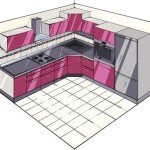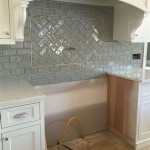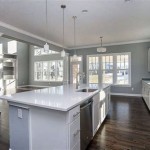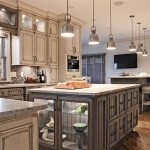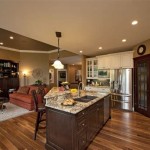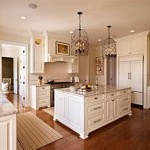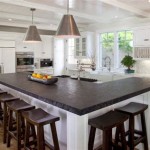Painted Kitchen Cabinets: A Transformation Through Before and After Photos
Kitchen cabinets often represent a significant portion of a kitchen's visual impact. Over time, cabinets can become dated, worn, or simply no longer align with evolving design preferences. Replacing kitchen cabinets can be a considerable expense. Painting offers a more economical and efficient means of updating a kitchen's aesthetic. Examining before-and-after photographs of painted kitchen cabinets provides a clear understanding of the potential for impactful transformation and allows homeowners to visualize the possibilities within their own spaces.
The process of painting kitchen cabinets requires meticulous planning, preparation, and execution. Viewing before and after images helps illustrate not only the color change itself, but also the improvements that careful preparation can bring, such as filled imperfections, smoother finishes, and updated hardware. The dramatic difference showcases the power of paint to invigorate even the most tired kitchen.
Key Considerations When Evaluating Before and After Photos
Analyzing before-and-after examples provides valuable insights into the nuances of cabinet painting. Focus on these key elements to better understand the process and assess the quality of the work.
Surface Preparation: One of the most critical aspects of a successful cabinet painting project lies in surface preparation. In before photos, look for signs of wear and tear, such as chipping paint, scratches, grime buildup, and uneven surfaces. After photos should demonstrate a smooth, uniform finish, free from imperfections. A poorly prepared surface will invariably result in a subpar paint job, leading to peeling, bubbling, and an overall unprofessional appearance. The goal is to create a pristine canvas that allows the paint to adhere properly and provide a durable, long-lasting finish. Proper preparation typically involves degreasing, sanding, filling any holes or cracks with wood filler, and priming.
The effectiveness of cleaning and degreasing can be seen in the after photos. Cabinets that were previously dull and grimy should now appear bright and clean, without any lingering residue that could affect paint adhesion. Sanding is crucial for creating a slightly rough surface that allows the primer to grip effectively. Wood filler, when used correctly, should be invisible beneath the paint, leaving no trace of the original damage.
Paint Application Techniques: The application of paint directly impacts the final look and durability of the cabinets. Observe the after photos closely for signs of brushstrokes, roller marks, drips, or uneven coverage. A professional paint job should exhibit a smooth, even finish, regardless of the application method used (brush, roller, or sprayer). Sprayers often provide the most consistent and flawless finish, minimizing visible imperfections. However, skilled painters can achieve excellent results with brushes and rollers, particularly with careful technique and high-quality paint.
Consider the type of paint used. High-quality paints formulated specifically for cabinets offer superior adhesion, durability, and resistance to chipping and scratching. Look for paints that are self-leveling, meaning they minimize brushstrokes and roller marks as they dry. The sheen of the paint also plays a significant role in the overall aesthetic. Options range from matte to high-gloss, each offering a different look and level of durability. Semi-gloss and satin finishes are popular choices for kitchen cabinets, as they provide a balance of durability and ease of cleaning.
Hardware and Detailing: Changing the hardware can significantly enhance the impact of painted cabinets. Assess the before and after photos to see if the hardware was updated and how it contributes to the overall design. New knobs, pulls, and hinges can instantly modernize the look of the kitchen. Consider the style and finish of the hardware in relation to the cabinet color and overall kitchen design. Brushed nickel, stainless steel, and black finishes are popular choices for contemporary kitchens, while antique brass and bronze finishes can complement more traditional styles.
Beyond hardware, other details can make a difference. Filling old hardware holes and drilling new ones can ensure that the new hardware is properly aligned and securely attached. Also, consider whether moldings and trim were updated as part of the painting project. A fresh coat of paint on the trim can tie the entire look together and create a cohesive design.
Illustrative Examples of Cabinet Painting Transformations
Numerous before-and-after scenarios commonly occur when painting kitchen cabinets. Examining these typical situations provides homeowners with a framework for understanding the process and evaluating the potential outcomes.
From Dark Wood to Light and Airy: One frequent transformation involves painting dark wood cabinets a lighter color, such as white, cream, or light gray. This change can dramatically brighten the kitchen and create a more spacious and airy feel. Before photos often show kitchens with dark, dated cabinets that absorb light and make the space feel smaller. After photos showcase the transformative effect of light-colored cabinets, which reflect light and create a more inviting atmosphere. This type of project often involves extensive surface preparation to ensure proper paint adhesion to the existing wood finish. Multiple coats of primer and paint may be required to achieve full coverage and prevent the original wood color from bleeding through.
Updating Oak Cabinets: Oak cabinets, characterized by their prominent wood grain, are often a target for painting. Before photos typically show the dated look of oak cabinets with their visible grain pattern. After photos demonstrate how painting can minimize the appearance of the grain and create a more modern and seamless look. While the grain may still be slightly visible, a proper paint job can significantly reduce its prominence. The key to painting oak cabinets successfully is to use a grain filler to smooth out the surface before priming and painting. This helps to prevent the grain from showing through the paint and creates a more uniform finish.
Adding Color and Personality: Painting cabinets allows homeowners to introduce color and personality into their kitchens. Before photos may show kitchens with neutral or bland cabinets that lack visual interest. After photos demonstrate how painting cabinets in a bold or unexpected color can transform the space and reflect the homeowner's personal style. Consider the overall color scheme of the kitchen and choose a cabinet color that complements the existing elements, such as countertops, backsplash, and flooring. Two-tone cabinet schemes, where upper and lower cabinets are painted in different colors, are also a popular option for adding visual interest.
Addressing Wear and Tear: Over time, kitchen cabinets can accumulate wear and tear, such as scratches, chips, and stains. Before photos often show cabinets with these imperfections, which detract from the overall appearance of the kitchen. After photos demonstrate how painting can effectively conceal these imperfections and restore the cabinets to their former glory. Proper surface preparation is essential for addressing wear and tear. Filling any holes or cracks with wood filler, sanding down rough edges, and priming the surface will create a smooth, uniform canvas for painting. A high-quality paint that is resistant to chipping and scratching will help to protect the cabinets from future damage.
DIY vs. Professional Cabinet Painting: A Visual Comparison
The decision to paint kitchen cabinets as a DIY project or hire a professional painter hinges on various factors, including skill level, time commitment, and budget. Before-and-after photos can provide a stark visual comparison between the outcomes of DIY and professional cabinet painting jobs.
DIY projects, while potentially cost-effective, often exhibit imperfections that are not present in professional paint jobs. These imperfections can include visible brushstrokes, uneven coverage, drips, and a lack of attention to detail. Before photos of DIY projects may show cabinets that were poorly prepared, leading to paint adhesion issues and a less-than-smooth finish. After photos may reveal the limitations of DIY techniques, such as difficulty achieving a consistent color and sheen across all cabinet surfaces.
Professional cabinet painting, on the other hand, typically results in a flawless and durable finish. Professionals have the experience, tools, and expertise to properly prepare the cabinets, apply paint evenly and smoothly, and pay attention to every detail. Before photos of professional projects may show cabinets in similar condition to those of DIY projects, with wear and tear and outdated finishes. However, the after photos often demonstrate a significant improvement in quality and appearance. Professionals are more likely to use spray equipment that creates a factory-like finish. They can also have access to high-quality paints and finishes not readily available to consumers, further enhancing the durability and appearance of the painted cabinets.
Examining before-and-after photos that specifically highlight the differences between DIY and professional work can help homeowners make an informed decision about whether to tackle the project themselves or hire a professional.
Ultimately, the successful transformation of kitchen cabinets through painting demands careful planning, meticulous execution, and a commitment to detail. The visual evidence provided by before-and-after photographs serves as a powerful tool for understanding the process and appreciating the potential for dramatic change that painted kitchen cabinets can bring.

Painted White Cabinets Before And After Reveal Photos Renovated Faith

Diy Kitchen Makeover Painted Cabinets Before After

Pa Wedding Photographer Diy Painted Kitchen Cabinets Before After

Our Painted Cabinets Five Years Later Nina Hendrick

Update On Our Diy White Painted Kitchen Cabinets 2 Years Later

Painted Kitchen Cabinet Ideas And Makeover Reveal The Polka Dot Chair

Kitchen Painting Projects Before And After Paper Moon

A Builder Grade Kitchen Gets New Look With Classic Features Like Gray Cabinets Quartz Counters And Subway Tile Truly Inspiring Before After Re

Diy Painting Your Kitchen Cabinets The Right Way

Oak Kitchen Makeover Painting Cabinets Cabinet Before And After Youtube
See Also

